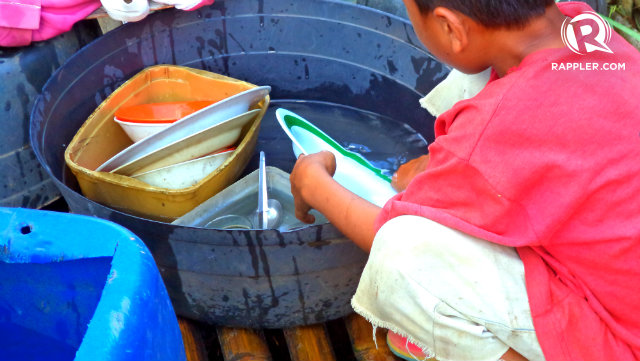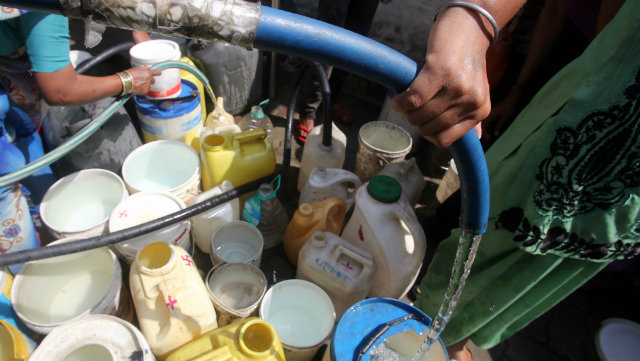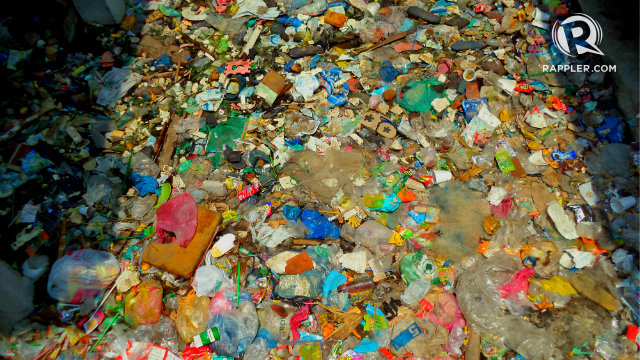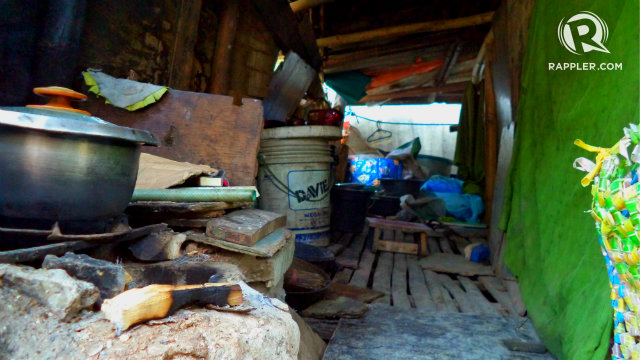SUMMARY
This is AI generated summarization, which may have errors. For context, always refer to the full article.
MANILA, Philippines – Half of Filipino households, as of 2011, did not try to make their drinking water safe, according to the latest National Nutrition Survey (NNS).
Not everyone has access to proper sanitation and hygiene. This can impact on individual health, and in the long-run, the country’s overall productivity.
Providing better water systems can help “improve socio-economic, health and nutrition status of households,” the Food and Nutrition Research Institute (FNRI) advised.
Every 21 seconds, a child dies globally from water-related illnesses, international non-profit organization Water.org estimated. This is mostly due to water contaminated by fecal matter – because many families still lack toilets.

As of 2010, 16% of Filipino households lacked access to clean and potable water, the National Statistical Coordination Board reported. (READ: 55 die daily due to lack of proper PH sewerage)
Annually, around 6,000 Filipinos die prematurely from such diseases. In fact, diarrhea is the country’s second leading cause of death, the Department of Health (DOH) stressed.
|
Bottled/Mineral water as main source of drinking water among Filipino households |
|
|
2008 |
2011 |
|
15% |
22.8% |
(Source: National Nutrition Survey, FNRI)
The percentage of Filipino households depending on bottled water has been increasing, but not everyone can afford this.
Water is not only necessary for drinking, but also for cooking and agriculture. Hence, the lack of it may also contributes to malnutrition, says the World Health Organization (WHO).
‘Right to water’
The UN recognizes one’s access to water and sanitation as a basic human right:
- Sufficient: Individuals need 50-100 liters of water/day for personal and domestic use. Poor families use only 5 liters or less, equivalent to what rich countries use to flush toilets
- Safe: no harmful microorganisms, chemicals, health threats
- Accessible: Water source must be within 1,000 meters of the house; collection time should not exceed 30 minutes. Meanwhile, some Filipinos still walk long distances while carrying heavy buckets of water to and from their house (READ: Future of PH rural roads)
- Affordable: Water costs should not exceed 3% of the household income
The UN declared 2005-2015 as the “water for life decade,” encouraging countries to create policies and actions addressing water issues.
Despite the UN Resolution, some Filipinos still remain thirsty, hungry, and dirty daily.
|
The world’s water problem |
|
|
*No access to basic sanitation |
2.5 billion (40% of global population) |
|
*No access to safe drinking water |
783 million (11% of global population) |
|
Child deaths (under age 5) per year related to water-related illness |
1.5 million |
|
School days per year lost due to water-related illness |
443 million |
|
*Deaths per year due to inadequate water supply, sanitation, hygiene |
3.5 million |
(Source: UN Right to Water 2010, MDG 2012, *UN Water 2013)
The Millennium Development Goals (MDGs) include halving the population without access to drinking water; this was achieved in 2010.
However, a lot of work is yet to be done in terms of “sustainability, safety, and reliability.”
Those in urban areas have better access to water services and toilets than those in rural areas, according to UN Water.
|
Proportion of population among rural areas using improved drinking water sources |
|
|
Malaysia |
88% |
|
Thailand |
86% |
|
Philippines |
84% |
|
Indonesia |
70% |
(Source: WHO 2012)
These water-related problems hinder countries from achieving other MDGs such as improving health and education, reducing hunger, poverty, maternal and infant deaths, and ensuring environmental sustainability.
With enough research and government support, water may also be tapped as an energy source – hence contributing to economy and sustainable development.
Climate change and pollution also affect water availability and may intensify droughts – which can then impact livelihoods and food security.
By 2030, the UN expects global food and water demand to double. Water resources must be properly managed; otherwise, supply may not meet the demand.
To address the issue, the Philippines has the “Water Code of 1976” and the National Water Resources Board which focus on water resources ownership and management.
The country has the “Sanitation Code of 1975” which sets standards on food, water, toilets, among other public goods, services, and establishments. The DOH also prescribed standards on drinking water.
Not all Filipinos, however, directly benefit from these policies.
In 2011, then senator Eduardo Angara filed SB 2997 or the “Water Sector Reform Act” which proposed to increase funds and to improve the country’s water supply and sanitation management.
The bill remains pending.
Women, water

Worldwide, women spend roughly 200 million hours per day collecting water, Water.org estimated. This translates to 6 hours per woman or girl, UN said.
These hours could have been better spent at school.
In many countries, including the Philippines, women are primarily expected to feed the family. This burden is often shared by mothers and daughters alone.
Around 2 liters of water/day is needed for meal preparation, individuals drink 2-4 liters/day, while lactating mothers need at least 7.5 liters/day. Water is also needed for cleaning, laundry, and maintaining plants or livestock.
This may not seem much, but for poor households, this may already seem too much and too expensive.
The task to secure all these is often shouldered by poor women.
Another problem is the lack of clean and safe toilets for girls.
The UN observed that some girls across poor countries “avoid drinking water at school to avoid urination, thereby becoming dehydrated and unable to concentrate.” They did this either because their schools have no or have poorly maintained toilets.
“Girls would also stay away from school when menstruating,” UN added.
In agriculture, if female farmers had the same access to irrigation as men, their yields could increase by at least 30%; this could help 150 million hungry people, according to UN Water.
Thirsty, sick
Improper sanitation and hygiene may lead to illnesses such as dehydration, cholera, diarrhea, malaria, typhoid, intestinal worms, eye infections, and even skin and bone problems.
Waterborne diseases are more common among developing nations either because people cannot afford proper services or are unaware of sanitation standards. Or governments provide poor social services and infrastructure.
“Investing in water and sanitation is costly. Yet evidence has shown that the cost of not ensuring access to drinking water and sanitation is even higher in terms of public health and lost work and school days,” the UN warned.
In 2010, DOH, together with the Department of the Interior and Local Government and the National Anti-Poverty Commission (NAPC), began conducting the “Sagana at Ligtas na Tubig Sa Lahat Program.”
The program provides capacity-building for local government units and water service providers, as well as water supply systems for waterless areas:
- Municipalities
- Barangays
- Health centers
- Resettlement sites
As of 2012, the program has covered 290 out of its 455 targeted beneficiaries. It plans to cover the rest from 2013-2016, with an annual budget of P1.5 billion, according to a NAPC statement.
Its end goals are to increase water service for the waterless population by 50%, to improve sanitation services, and to reduce cases of water and sanitation-related diseases.
The UN cited the inadequate treatment of human waste, as well as agricultural and industrial wastes, as the most common sources of water pollution.
|
Filipino households without toilets |
|
|
2008 |
2011 |
|
8.1% |
9.6% |
(Source: National Nutrition Survey, FNRI)
As an alternative, some Filipinos use the streets, bodies of water, and their backyards as toilets and garbage disposals.
Pricey
A 2006 UN study found that families from Manila slums “pay 5-10 times more for water” than those from high-income areas.
They also pay more than those in London and New York.
“In Manila, the cost of connecting to the [water] utility represents about 3 months’ income for the poorest 20% of households,” the study said.
These conditions violate one’s rights to water and sanitation. “Right to water” does not mean “free water for all,” but affordable water.
On the other hand, some Filipinos – indifferent to the needs and woes of others – tend to waste and take water for granted.
By 2025, two-thirds of the world’s population may be threatened by water scarcity, UN Water estimated. – Rappler.com
How can we help fight hunger, its causes, and effects? Share your stories and ideas with us. Report what your LGU is doing, recommend NGOs, or suggest creative solutions. E-mail us at move.ph@rappler.com. Be part of the #HungerProject.
Add a comment
How does this make you feel?




There are no comments yet. Add your comment to start the conversation.